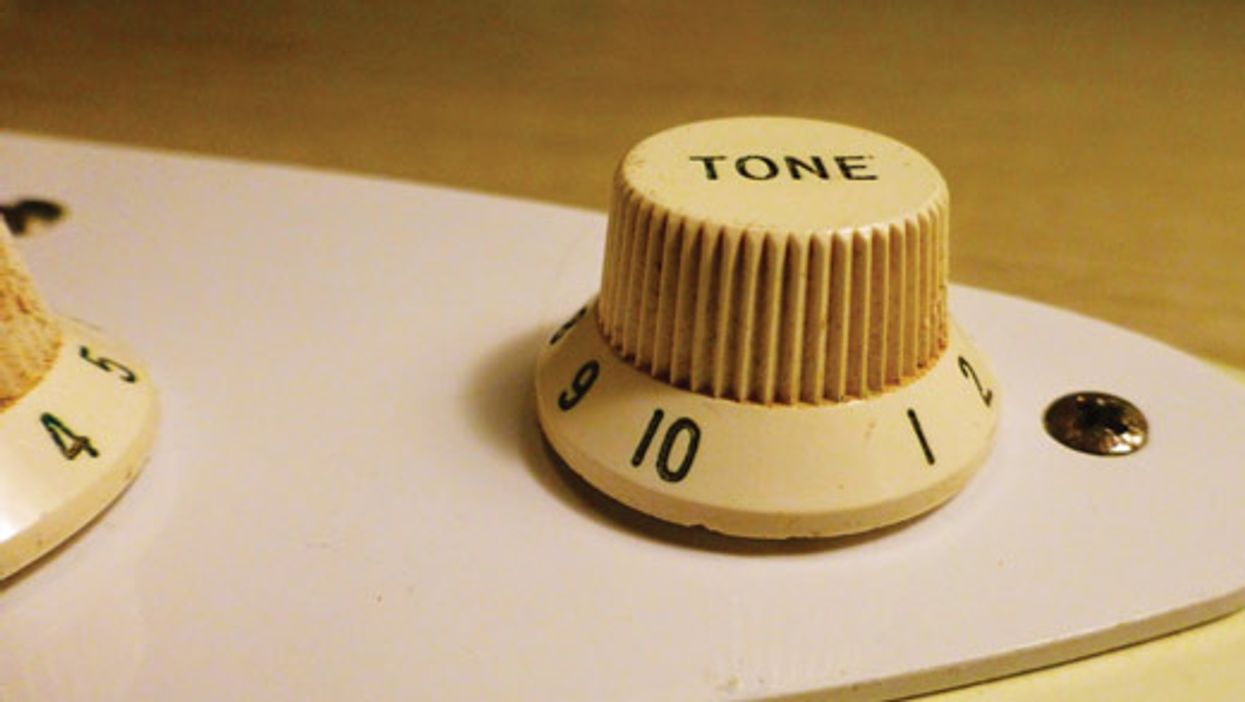I often hear guitarists say they leave their tone control on 10 all the time—or even disconnect it—because they find it useless. A small turn from wide open takes the tone from “lively" to “clinically dead," and that's all you get. Why is this a common problem with passive guitars? Typically, it's because of two reasons: 1) The tone pot has an ineffective taper and/or resistance, and 2) the tone cap has too much capacitance. Both issues are easy to fix, so let's explore the remedies.
In a passive guitar, the typical tone control is a capacitor connected to a potentiometer—that's it. Because the system is so simple, both components must be chosen carefully to make it work well. Players often complain that the tone pot functions as an “on-off" knob, rather than a control that provides a gradual and even effect over its entire rotation. Fortunately, we can deal with this.
The tone pot. Because of how our ears work, the tone pot inside a passive guitar must be an audio (aka logarithmic) type, not a linear type. (This also applies to a volume pot in a passive system.) The “on-off" problem is typical of audio pots with a ratio of 90:10, which is more or less the standard today. Human hearing simply doesn't work like this and needs a different ratio, preferably 60:40, or at least 65:35, which was the standard in the '50s and '60s. [Editor's note: These ratios indicate the percentage of total resistance measured at the middle of the shaft rotation, i.e., at 5 on a typical knob.]
Using a linear pot as a tone control creates a different problem: There's no apparent change in tone over almost the whole rotation until the “on-off" effect suddenly appears at the very end—exactly the opposite of an audio pot with an ineffective taper.
Besides the pot's type and taper, its resistance can make things worse in a passive system. A simplified rule of thumb: The higher a pot's resistance, the less effective it will be as a volume or tone control. This means 250k and 500k pots work well in these applications, while a 1M pot is pretty useless.
So what's the perfect tone pot for a passive guitar? It's a 250k or 500k audio type with a 60:40 or 65:35 taper. I use a 250k audio type with a 60:40 taper along with a no-load mod, which makes the pot disappear from the circuit when it's fully opened. This recipe preserves a good portion of the high end. Compared to a 500k pot, a 250k pot offers a bit more controllability, but it adds more load to the circuit—that's the nature of the passive beast. The no-load mod compensates for this problem.
The tone cap. The second element in the tone control system is dominated by two factors: type (construction) and capacitance. The type—ceramic, polyester, paper-in-oil, etc.—dictates the overall tone, while the capacitance determines how dark the tone will get when closing the tone pot. Some people claim that when wired into a guitar, all cap types sound the same, but if you experiment with this, I'm pretty sure you'll reach a different conclusion. In previous Mod Garage columns, I've discussed various types of tone caps and how they perform, so we don't need to rehash this here.
Capacitance is often described as “value," and the typical range for guitars is from 0.022 µF up to 0.1 µF. Over the years, cap values have steadily decreased from the original 0.1 µF that Leo Fender chose, so “a guitarist can also play bass lines," to 0.05 µF, which was the standard in the late '60s and '70s, to 0.022 µF, which is the quasi-standard for single-coil pickups today.
But let's face it: Even in the '50s, guitarists never wanted to play bass lines on their Telecasters, and even 0.022 µF is overkill for most players. In other words, 0.022 µF makes the tone incredibly dark and lifeless when the tone pot is closed, which is exactly why so many guitarists don't use their tone control at all. So it's time to fix that! The easy and effective solution is to replace the tone cap with one that has way less capacitance. This will morph the pot into a “warmth control." Capacitors in the picofarad range (pF) are perfect for this, and a useful range to experiment with is from 1000 pF up to 6800 pF.
And that's where we'll pick things up next time. I'll discuss some of the most popular values and what you can expect sonically from them. Until then, keep on modding!











![Rig Rundown: Russian Circles’ Mike Sullivan [2025]](https://www.premierguitar.com/media-library/youtube.jpg?id=62303631&width=1245&height=700&quality=70&coordinates=0%2C0%2C0%2C0)







